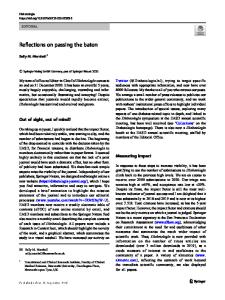Reflections on Problem-Solving
The chapter includes four contributions on different aspects of the relationship between problem solving in mathematics and in mathematics education. Gerald Goldin points out that besides the importance of teaching students how to solve certain classes of
- PDF / 370,959 Bytes
- 23 Pages / 441 x 666 pts Page_size
- 60 Downloads / 376 Views
Reflections on Problem-Solving Problem Solving in Mathematics and in Mathematics Education Boris Koichu Abstract The chapter includes four contributions on different aspects of the relationship between problem solving in mathematics and in mathematics education. Gerald Goldin points out that besides the importance of teaching students how to solve certain classes of problems, problem solving is a means of achieving some more general purposes pertaining to mathematics learning. Israel Weinzweig develops the claim that certain sequences of mathematical questions can provide students with problem-solving experiences similar to those of research mathematicians, and that such experiences are beneficial for promoting students’ conceptual understanding. Shlomo Vinner discusses the role of schemata and creativity in mathematical problem solving, and argues that the notions “problem solving in mathematics” and “problem solving in exam-oriented mathematics instruction” are incompatible. Roza Leikin presents a study aimed at identifying unique cognitive traits of intellectually gifted students who have the potential to become research mathematicians in the future. The chapter concludes with a reflective summary, in which the points made by the contributors are considered as parts of a longer-term debate on the relationships between problem solving in mathematics and in mathematics education, a conversation that has developed over the years according to a certain spiral pattern. Keywords Conceptual understanding · Dimensions of mathematical giftedness: creativity · Cognition · Neuro-cognition · Insight-based and routine problems · Evolution of problem solving within mathematics education · Problem-solving expertise · Problem solving by mathematicians · Teaching for problem solving · Teaching through problem solving
With contributions by Gerald A. Goldin, Rutgers University, Piscataway, NJ, USA A. Israel Weinzweig, University of Illinois at Chicago, Chicago, IL, USA Shlomo Vinner, Achva College of Education, Hebrew University, Ben-Gurion University of Negev, Jerusalem, Israel Roza Leikin, University of Haifa, Haifa, Israel B. Koichu (B) Technion—Israel Institute of Technology, Technion City, Haifa 32000, Israel e-mail: [email protected] M.N. Fried, T. Dreyfus (eds.), Mathematics & Mathematics Education: Searching for Common Ground, Advances in Mathematics Education, DOI 10.1007/978-94-007-7473-5_8, © Springer Science+Business Media Dordrecht 2014
113
114
B. Koichu
Introduction Problem solving was put on mathematics education agenda under the tremendous influence of the book “How to solve it?” written by a prominent mathematician George Pólya in 1945 (e.g., Schoenfeld 1992). Keen interest in problem solving emerged in the mathematics education community since there and has been sustained until today for a clear reason: mathematical problem solving (including problem posing, conjecturing and proving) is the central activity in mathematics as a living science, and thus it has been hoped that it would also become the cen
Data Loading...











